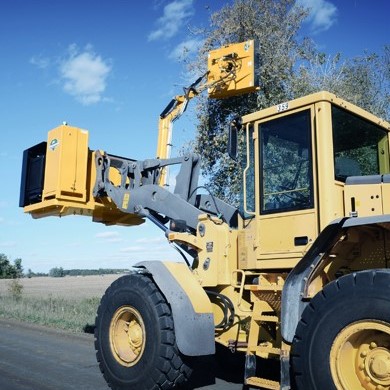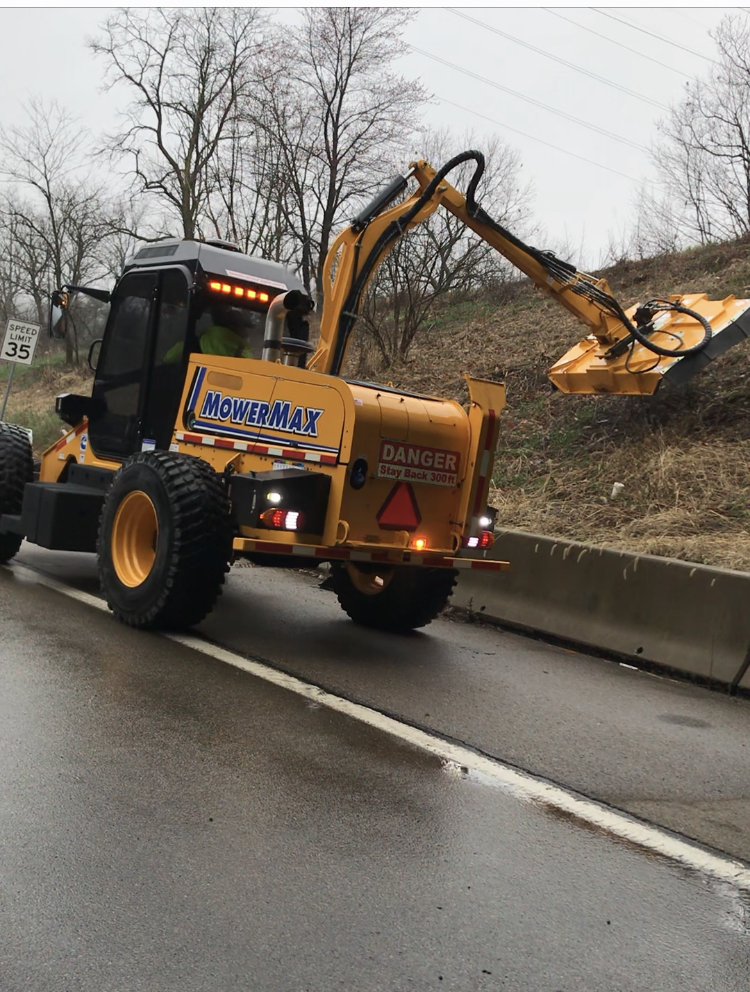PennDOT and several local governments are exploring brushing loader attachments for their equipment inventories as a way to improve the efficiency and safety of roadside vegetation management.
The State Transportation Innovation Council's (STIC) Maintenance Technical Advisory Group (TAG) is working on advancing this innovation to help crews be more efficient, increase operator visibility, and reach overhead obstacles that would otherwise prevent effective tree or brush trimming.
 A brushing loader attachment can be connected to loaders 25,000 pounds and larger to trim trees and brush along the roadway. From the safety of the loader's cab, an operator can effectively complete tree canopy removal and conduct daylighting and brushing operations, which is a key standard of care activity for all counties in Pennsylvania.
A brushing loader attachment can be connected to loaders 25,000 pounds and larger to trim trees and brush along the roadway. From the safety of the loader's cab, an operator can effectively complete tree canopy removal and conduct daylighting and brushing operations, which is a key standard of care activity for all counties in Pennsylvania.
Fermanagh Township in Juniata County held a demonstration in mid-March for a brushing loader attachment it had purchased. PennDOT's Fleet Management Division participated in the demonstration.
"Our Fleet Management Division employees liked the equipment and it had a lot of benefits," said Dean A. Poleti, P.E., Maintenance TAG leader and maintenance services engineer in PennDOT's District 11 in the Pittsburgh region.
 A second demonstration was held later in March at the Interstate 79 interchange in Carnegie, Allegheny County, with a Mower Max piece of equipment. Organized by PennDOT's Fleet Management Division, the demonstration was attended by employees from PennDOT's Operations and Performance Office along with representatives from PennDOT's District 11, including several PennDOT Beaver County equipment operators.
A second demonstration was held later in March at the Interstate 79 interchange in Carnegie, Allegheny County, with a Mower Max piece of equipment. Organized by PennDOT's Fleet Management Division, the demonstration was attended by employees from PennDOT's Operations and Performance Office along with representatives from PennDOT's District 11, including several PennDOT Beaver County equipment operators.
"The Mower Max is a stand-alone piece with different attachments for mowing and vertical vegetation removal," Poleti said, adding: "It is a nice piece of equipment with a lot of versatility."
The Maintenance TAG is looking to purchase a brushing loader attachment to use for pilot purposes statewide and see how it works. The piece of equipment would be rotated among the districts to see how PennDOT equipment operators like it and get their feedback.
"With a brushing loader attachment, there is a lot of versatility," Poleti said. "It would keep someone inside the cab rather than have that individual exposed while using a weed whacker or chainsaw working on a hillside where they could fall or twist an ankle. Anything to make the job more mechanical will be safer for employees. The same is for townships or other municipalities. It will help them be more efficient and handle longer stretches of roadside."
Since the attachments usually go on front loaders and not all municipalities have front loaders, Poleti noted there would be
Agility opportunities available to make this work statewide.
"If PennDOT owned the front loader attachment, we could send an operator to a township for whatever roadside management was needed, and the township could offer one of their services in exchange," Poleti said. "It definitely has Agility potential."
The Maintenance TAG is also developing a catalog of innovative vegetation management equipment for use by PennDOT county managers and their assistants as well as local governments. Once finalized, the catalog will be an easy reference for PennDOT and its partners to select innovative tools for clearing tree canopies and other roadside vegetation. This could include vegetation removal-related equipment, roadside mowers, tree shearers, forest mulchers and attachments to mow around high-tension cables.
The Innovation Development Team, led by PennDOT's Fleet Management Division Chief and Innovation Owner, Michael A. Martin, has developed a draft of the catalog and is now making modifications and adding equipment photos. He expects that final editing and formatting may take several more months. The catalog will provide best practices and equipment availability for sharing opportunities.
"With the catalog, the maintenance staffs from all of our partners can sit down and identify pieces of equipment that serve as best practices and which they would like to use," Martin said.